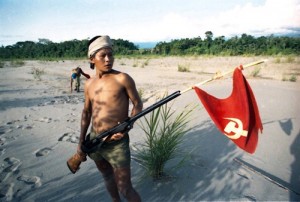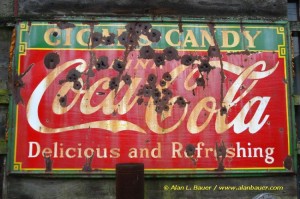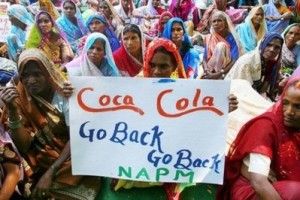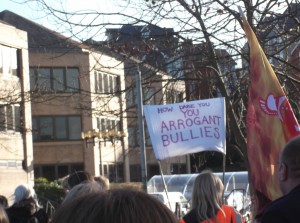
Interview
First of all, I would like to identify myself as a follower of the Communist Party in Peru. The Party, which has fought and fights to overthrow the state of Peru, which has outdated and lost its utility. On top of its ashes a new democratic state and government should be erected (referred to as a “Maoist” democratic state, neither a liberal capitalist nor a parliamentary democratic system).
1. How and when did you begin to be interested in politics?
When I was in secondary school we started to be influenced by the Russian and Cuban Revolutions and we admired the actions of the MIR (Movimiento de Izquierda Revolucionaria, Revolutionary Left Movement), which began to carry out guerrilla tactics. Moreover, we were influenced by peasant unions led by Hugo Blanco and above all, Ché Guevara, who sacrificed his life for the cause of the revolution and the people. After my professional training, I was educated in Christian schools by priests, where I was taught about metaphysical philosophy and became a great follower of the ideas of Plato, as well as acquiring knowledge about the ideas of San Agustin, Santo Tomas de Aquino and Immanuel Kant. I then carried out other studies at the University in the 1960´s and it is then when I got to see the other side of the coin; the philosophical branch of materialism and dialectics. Living in times where an emergence of political interest, political convulsion and social crises were taking place, I participated in popular mobilisations and I became part of Vanguardia Revolucionaria (Revolutionary Vanguard). Vanguardia Revolucionaria worked with peasants and workers, and fostered the development of the takeover of land by peasants in Andahuaylas. However, this organisation ended up succumbing to the parliamentary system put in place in the 1980´s because it was mainly an organisation formed by the petty bourgeoisie and it was greatly opportunist. Furthermore, the majority of the militants became lineated with the central government, in the same way as militants from other parties such as the PCR, PSR, among others.
2. Did you have any mentors? Did any particular professor, writer, and philosophers influence you?
As said before, I began studying metaphysics/idealist philosophy, but much later I identified with dialectical materialism. I believe and I am confident that dialectics, which contains as a main thesis contradiction, is the only form to change things in the social and political sphere in favour of the majorities.
3. When did you begin to read Marx, Engels, Lenin and Mao?
During my professional training at the university and working with popular sectors, I began to get in contact with Marxist ideology through the readings of the “Verdad Proletaria” (Proletarian Truth) that identified itself with the policies of the Communist Party of Peru (PCP). Subsequently, I became a follower of these policies and it is then that, within this organism, I started systematically reading and consciously the essays by Marx, Engels, Lenin and Mao, and hence grasping these ideologies as Marxism, Leninism and Maoism. The meaning of “ism” should be understood as a theory geared towards action, change and its application is to understand the world as a science. Each of these ideologies; Marxism, Leninism and Maoism, should be seen in its time and historical context.
4. When did you decide to become a member of the Communist Party in Peru?
For security reasons and due to the clandestine status of the PCP led by president Gonzalo, I should indicate that I adhered to its political positions. About the history of the PCP, I should indicate that the party was founded by José Carlos Mariategui and was reconstituted after 15 years since its foundation due to internal ruptures. The party at that time was divided into two main ideological lines, firstly the Pro-Soviet Communist Party strand led by Jorge Del Prado, mainly due to the political rupture between the Soviet Union and China, and the political positions of the Communist Party of Peru, Patria Roja in 1969, whose slogan was “power grows out of a gun”. The latter strand sought the takeover of the state through violent means, although in practice they never carried out such actions and have now turned to electoral politics. I became a member of the PCP, led by president Gonzalo, because I believed and believe that we can only grasp power through violent revolution and that this party was the only guarantee to foster a real revolution in favour of the people.
5. Explain the political, economic and social context in Peru in the 1970s and 1980s, and during the 1980s elections.
The characterisation by the PCP- president Gonzalo of Peruvian society was one in which the country was in a semi feudal and semi colonial phase, under which a bureaucratic capitalist system developed. This meant that capitalism didn’t develop the same way as in other countries, industrialisation wasn’t carried out effectively, nor was it done for national interests, which left the agrarian system and latifundismo as well as the repressive serfdom system intact. In the large cities, the overcrowding of people in urban slums, the creation of pueblos jovenes and settlements where high unemployment and poverty could be observed, which furthered the polarisation of the Peruvian society. The semi colonial aspects of the Peruvian economy were and still are the mining and fishing sectors, in addition to the agricultural sector, which are owned by imperialists, mainly the United States. It is for the latter reason that the key enemies of the Peruvian people are imperialism, the bourgeoisie and landlords, whom under subtle and new forms still exploit the people. It is under this context that popular protests begin to intensify and the calling of elections takes place under the de facto military government of Velasco Alvarado and Morales Bermudes. But the PCP-president Gonzalo, having made a correct analysis of the economic, political and social crisis in Peru and above all, the in crescendo popular protest, decides to initiate the armed struggle represented by the first rebel action in Chucchis-Ayacucho by destroying and burning the ballot boxes.
6. What is the Shining Path? What are its origins, philosophy, politics and ideology? Who is Abimael Guzmán?
The Shining Path is a name or appellative used by reactionaries or opportunists to refer to the real Communist Party in Peru (PCP) led by president Gonzalo. The name came about from an article titled “Through the shining path of José Carlos Mariategui” edited by a student movement in Lima, which was an auxiliary component of the party. The article tried to uncover the real dimensions of what a real Communist Party should look and act like in an international context. The Communist Party of Peru (PCP-president Gonzalo) originated from the Communist Party founded by José Carlos Mariategui in 1928. Its philosophy is based on dialectical materialism, particularly following an ideology of Marxism-Leninism-Maoism-Pensamiento Gonzalo (Gonzalo’s thought). This ideology is applied as a science, a revolutionary one, in Peruvian reality. It is this masterly implementation, which is neither “tracing nor copying” from other revolutionary experiences, but I repeat, an implementation to reality, through the violent capture of power by destroying the old and expired state that will enable us to create a new democratic state and government. We can now say that Abimael Guzmán, president Gonzalo who embodied the ideology of Marxism-Leninism-Maoism, applied the latter to the concrete reality of Peru, reconstituted the Party after 15 years and erected to take up the leadership of the Party. It was only under the conditions of this machinery, the Central Committee, which would have enabled the initiation of the process of revolution in Peru through a popular struggle.
7. Why did the PCP-president Gonzalo uptake a vanguard stand with a Marxist-Leninist-Maoist ideology? And why did it decide to take up arms to capture power after the elections of 1980?
It is Marxist because it has a philosophical ideology based on dialectic materialism, and it serves us as a guide for revolutionary practice, in other words, there cannot be theory without revolutionary practice, and vice versa, there cannot be revolutionary practice without theory. The latter has served to make revolutions possible such as in Russia, China, Albania and other countries. Moreover, the Communist Manifesto written by Marx and Engels demonstrate that the destiny of mankind is the abolition of class struggle and foster a future in which human beings can live in peace and tranquillity. Leninism is the concrete application of Marxism in the events that happened during the Russian revolution, which had been one of the first international experiences. Furthermore, Leninism represents the development of Marxism in the constant change of reality. A summary of Lenin’s thought is that imperialism is the superior stage of capitalism depicted by Marx and that a real revolution is carried out violently through the creation of a party with its own ideology and representing the workers. Maoism constitutes the third sword in the context of an international revolution, becoming a concrete application of Marxism-Leninism in the reality of China. China was essentially agrarian and feudal, where the peasantry head by the proletariat formed the revolution with a Communist Party led by president Mao Tse Tung. This was enabled through a violent revolution and the establishment of a democratic popular state with its sole mission being the development of a socialist state. In philosophical terms, Maoism contributed and stated that the law of contradictions was the only one that served for any type of transformation, in this case a social one.
The Communist Party of Peru entailing all these elements and past experiences applies them in the Peruvian reality. Firstly, achieving a unique party with an ideological Marxist-Leninist-Maoist tendency. Furthermore, given the semi feudal conditions and the agrarian problems that exist in Peru under the worker-peasant alliance, they manage to liaise with various popular sectors, including the petty bourgeoisie and even the national bourgeoisie, to achieve a new democratic state through violent means. This Marxist-Leninist-Maoist application to concrete reality in Peru led the CP in Peru to recognise the leadership of president Gonzalo (Abimael Guzmán), converting this qualitative development into “pensamiento Gonzalo” (Gonzalo’s thought). It is necessary to highlight that the CP-president Gonzalo was the only party that managed to accomplish a Marxist-Leninist-Maoist congress in the midst of a popular war, in addition to tracing its own revolutionary strategy and tactic as well as its political programme.
8. Did the Party work with other political groups? Why did the Shining Path choose conflict instead of co-operation or collaboration with other left-wing parties? With the peasantry or with the proletariat?
In addition to the answer to the previous question, there was no other leftist party with a Marxist-Leninist-Maoist ideology and the majority of the so-called leftist groups were simply revisionist, opportunists or served as a caboose for the regimes in power, in other words, they believed that revolutionary change could be achieved through the ballot box, they didn’t understand that the real revolution was to be made through the use of violence. We should pay close attention to the Movimiento Revolucionario Tupac Amaru (MRTA, Revolutionary Movement Tupac Amaru), which was not a party but a movement, as such; although they wished to rise in arms they didn’t posses a defined ideology and neither possessed a drive to arms since it had no programme nor revolutionary strategy or tactic. Their actions were limited to isolated actions and they weren’t an alternative that was truly revolutionary with the capacity to capture state power. Therefore, the PCP-president Gonzalo didn’t have to have a relationship with other leftist’s parties, nor movements, and much less ask for their collaboration.
The PCP-president Gonzalo was the expression of the proletariat and as such, the party formed an alliance with the peasantry and with other popular sectors, housing them in its womb, among sympathisers, militants, who are the best sons of the people to achieve the revolution in Peru.
9. What kind of tactics or actions were carried out against the state?
After having established the first military school the PCP-president Gonzalo initiated violent actions, without weapons, against the decrepit Peruvian state, which possessed badly needed resources. The aims were to be achieved through the development of guerrilla warfare tactics, taking in mind the experiences learnt in China, attacking the enemy by surprise and leading them where they would be in disadvantaged positions. The first actions carried out were sabotages and ambushes, stressing the usage of dynamite, to remove and scare the police from its garrisons. When the police left, the party was able to build popular committee’s and assign commissioners, who were commissioned for particular functions whether that be the economy, trade, justice, education and others. They were above all, under the leadership of the party and guarded by the Popular Revolutionary Army. Once Popular Committees were built, an extensive revolutionary base was set up in liberated territories, mainly situated in the highlands of Peru and in the most impoverished human settlements in the outskirts of the big cities. These forms of organisation would allow the party to realise the path to a new democratic state and achieve the continuation of the revolution from the countryside to the city.
10. What role were you given?
The actions carried out by the party were divided in two main commands; the political command, which was mainly in charge of studying and planning, obtaining the necessary materials and weapons and all that was needed to implement them, and the military command, which was in charge of executing the planned actions. Committed militants who directed the operations composed the former predominantly. When it comes to me, at times, I have complied with both commands and for security reasons I cannot reveal the sort of actions I was involved in.
11. Did the Shining Path work with drug traffickers? According to some investigations when Abimael Guzmán was captured, dollars charged from drug dealers in exchange for protection were found in the apartment collected by María Pantoja and Maritza Garrido Lecca.
It is completely false that the party worked with or had any ties to drug traffickers and I reject the statement that dollars charged from drug traffickers and collected by María Pantoja and Maritza Garrido Lecca were found in the apartment where Abimael Guzmán was captured. Any kind of montage to tie the party with drug traffickers is a humbug produced by the state and opportunists to try to discredit the party. It should be stated that the party was financed by the collaboration of the people, from whom the party collected money or food to maintain the party and relied on to keep an independent representation, which was one of the reasons to become less dependent from other classes and solely dependent on the “pueblo”.
12. Once rural and urban areas were captured what kinds of procedures were followed? According to the research i did communitarian elections were prepared as well as elections within unions.
As I said before, the party displaced the National Police from its garrisons to establish Popular Committees and revolutionary bases for support, in which popular elections were carried out to name commissioners, the sons of the people, who possessed enough knowledge for certain tasks. The party directed and oriented these actions, as well as guarding the functioning of these institutions. If they didn’t comply with certain requirements the people normally changed them. In trade unions elections were voluntary and free. In some cases the commissioned leaders were sympathisers or followers of the party, which facilitated the propagation of ideas and the possibility of agitation during popular mobilisations. It was clearly understood that the trade unions were not the party and vice versa because while the Unions fought for their economic claims, the party fought to obtain power. The party worked with generated organisms such as the MOCT, the workers movement.
13. Why did the party lose popular support in the 1990’s? What is your opinion of this abstract, which accuses the Shining Path of unnecessary atrocities? *Many farmers expressed disagreement with the actions and thoughts of the Shining Path, due to their lack of respect for indigenous culture and its institutions in their efforts to start the revolution. Moreover, they neglected the Andean ancestral customs. But above all, the main obstacle to its popularity were the trials formulated in villages, which ended in barbaric acts when the Senderistas killed the “enemies of the revolution” by beheading, strangulating, stoning, even burning. In addition to judging cattle thieves, schoolteachers, priests, merchants and other lesser leaders were put on trail and executed.
To answer this question I should firstly explain that once popular committees were established and after displacing the police from its garrisons, the main task was to construct a new democratic state in revolutionary support bases. To confront this democratic threat established in peasantry communities, districts and provinces in the highlands of Peru, the Armed Forces, primarily the Army and the Navy, worked to annihilate not only the militants and commands of the party, the members of the Revolutionary Army and the commissioners of the Popular Committees, but to develop widespread killings and rape of women, destroying everything they could in their way. In order to achieve their goals the Armed Forces generated the mesnadas, which were soldiers from the Army or Navy dressed up as peasants, whom subjugated communities with the sole purpose of murdering the members of the party. Using this tactic the state carried out the murdering of thirteen innocent journalists in Uchuracay.
The actions of the mesnadas were blamed on the party and this lead to the ignorance and the casting of doubts, which had an effect on the credibility of the party. The party had to face the armed forces and the threat of the mesnadas infiltrated in the communities, which in turn led to the development of popular trials for those that, despite the warnings, kept representing the old state. All the executions were carried out through a popular trial, which meant that the people accused the enemies and corrupted people of the revolution. The sole task of the party was to meet with the mandate and it’s in this way that it never carried out senseless executions because either one was part of the authority of the old state or one formed part of the authority of the new state. The party never committed barbaric acts against the people, as the code of the party was “to not touch a single thread of the people”. Furthermore, the militants of the party practiced three main elements, which were to live, work and eat with the peasantry. On the other hand, the political task at a national level was still to be done possessing as a base Ayacucho. In this circumstance, it’s where president Gonzalo, identified as Dr. Abimael Guzmán Reynoso, is captured and with him the majority of the Central Committee of the CP. Since then, the government of Fujimori and his consultant Montesinos have utilised the law of repentance to effectively annihilate the party at a national level.
14. What is left of the party? What do you think about the faction Proseguir that is established in the VRAE (Valle del Río Apurimac y el Ene)?
Regarding the current movement, we remain subject to the decisions of the party and geared towards reaching a peace agreement to end the war. The latter is to be understood as an end to the war that was begun. The peace agreement would mean the restructuring and reinforcement of the forces and agencies of the party. Regarding the faction Proseguir that continues its actions in the VRAE, they carry out isolated actions that don’t conform with the decisions made by the party and in any case, in due course, will understand the current situation that the party is facing.
15. Do you still believe in the political ideology and do you continue to support the party?
As I said before, I am subject to the decisions of the party, I support the peace agreement to end the war and my political ideology is still Marxist-Leninist-Maoist-Gonzalo thought.
16. What is your opinion about the Truth and Reconciliation Commission?
In the wake of the ten years people’s war waged by the Communist Party of Peru against the state, the war had its costs, like any other war. The unfortunate decapitation of its leadership left the party without direction because “ a ship without directions, unfortunately shipwrecks”, and the inability of the party to struggle would mean the failure to capture power. The Truth and Reconciliation Commission states that the total number of victims caused by the war were 69, 280 people, of which 31, 331 people the Shining Path were responsible for. That does not fit the reality of the facts because there were successive governments such as the Belaunde Terry, the genocidal Alan Garcia and the corrupt Alberto Fujimori regimes, which developed the widespread killings, disappearances, mass burials against the popular sectors that supported the war and the members of the party. Therefore, it’s those people who are responsible for the deaths and disappearances that reported the Commission of Truth and Reconciliation.





